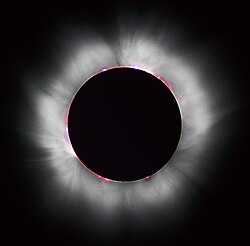恆星大氣層
恆星大氣層是恆星的最外層區域,位置在核心、輻射層和對流層之上,依照獨特的特徵可以分為數層:
- 光球層是大氣層的最底層,也是我們能觀察到的大氣層中溫度最低的一層[1]。來自恆星的光經由這一層從穿越更高的數層後,由恆星的表面逃逸入太空。太陽的光球層溫度為5700K到5,780 K範圍[2][3],星斑是光球層上受到磁場擾亂而溫度較低的區域[3]。

- 在光球層之上的是色球層,這一層開始時的溫度會下降,然後隨著高度上升逐漸增溫至光球層的10倍左右。
- 在這之上就是恆星大氣層的外圍部份,是由非常稀薄但極端高溫(百萬K)的電漿構成的星冕[5],過渡區和星冕是在主序帶上所有的恆星都有的外觀。但不是所有演化中的恆星都是如此,看起來只有一些巨星和極少數的超巨星才有星冕。在天體物理學中尚待待解決的問題是星冕是如何被加熱到如此高的溫度?答案可能在恆星的磁場上,但確切的機制依然還沒有被清楚了解[6]。
以太陽為例,當日全食之際,太陽的光球層被遮蔽時,大氣層中的其他層次便被顯露出來[1]。在這種情況下,色球層呈現出略帶粉紅色的圓弧[7],而日冕(太陽的星冕)像裝了一簇纓球的光暈。在食雙星同樣的現象可以讓巨星的色球層可見[8]。
參閱
編輯- 塞西莉亞·佩恩-加波施金 - 首先提出了當前接受的恆星大氣層組成的天文學家。
參考資料
編輯- ^ 1.0 1.1 "Beyond the Blue Horizon" – A Total Solar Eclipse Chase. 1999-08-05 [2010-05-21]. (原始內容存檔於2012-02-10).
On ordinary days, the corona is hidden by the blue sky, since it is about a million times fainter than the layer of the sun we see shining every day, the photosphere.
- ^ Mariska, J.T. The solar transition region. Cambridge Astrophysics Series. Cambridge University Press. [2017-06-18]. ISBN 978-0-521-38261-8. (原始內容存檔於2016-03-30).
- ^ 3.0 3.1 Lang, K.R. 5.1 MAGNETIC FIELDS IN THE VISIBLE PHOTOSPHERE. Sun, earth, and sky 2nd. Springer. September 2006: 81. ISBN 978-0-387-30456-4.
this opaque layer is the photosphere, the level of the Sun from which we get our light and heat
- ^ Mariska, J.T. The solar transition region. : 60. ISBN 978-0-521-38261-8.
100 km suggested by average models
- ^ R.C. Altrock. The Temperature of the Low Corona During Solar Cycles 21–23. Solar Physics. 2004, 224: 255. Bibcode:2004SoPh..224..255A. doi:10.1007/s11207-005-6502-4.
- ^ The Sun's Corona – Introduction. NASA. [2010-05-21]. (原始內容存檔於2012-02-10).
Now most scientists believe that the heating of the corona is linked to the interaction of the magnetic field lines.
- ^ Lewis, J.S. Physics and chemistry of the solar system Second. Elsevier Academic Press. 2004-02-23: 87. ISBN 978-0-12-446744-6.
The dominant color is influenced by the Balmer radiation of atomic hydrogen
- ^ Griffin, R. Elizabeth. Only Binary Stars Can Help Us Actually SEE a Stellar Chromosphere. Proceedings of the International Astronomical Union. 2006-08, 2 (S240): 700–705. ISSN 1743-9213. doi:10.1017/S1743921307006163 (英語).